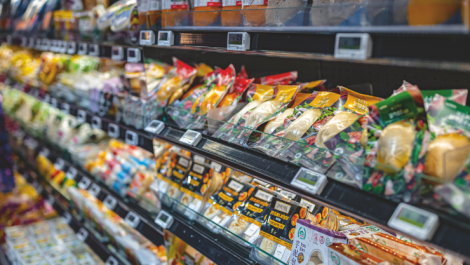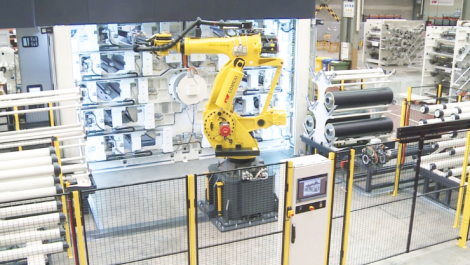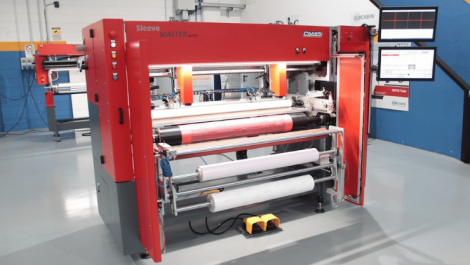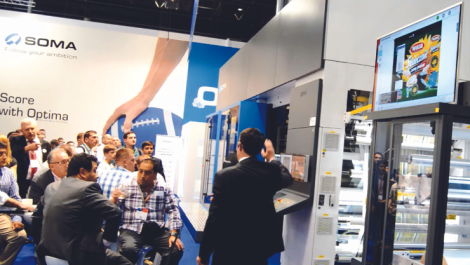The new Packster 3000V robotic palletiser was launched to an audience of more than 60 converters at the Van den Bos open house in June
In this article, we look beyond the printing itself to catch a glimpse of the surrounding processes and some of the machinery and products on the market. Whilst not necessarily impacting the print result as such, they can offer considerable savings, be it in time or costs, or improve the sustainability of the overall process. By Neel Madsen.
Further away from the print process, there are many other related areas where new and innovative products can help print companies cut costs and become more efficient.
Van den Bos officially launched the Packster 3000 robotic palletiser at an open house event in Almelo, Netherlands recently. The Packster 3000 series comes in a new compact design based on the simple and proven combination of three conveyors and three Kuka robots, all programmed and controlled by high-intelligence computer software. It uses standard components for inexpensive and easy maintenance, and is available with mechanical or vacuum clamps.
‘We have designed the Packster to offer maximum flexibility in operation. It is pre-loaded with 60 stacking patterns, and has the capacity to store special styles in its memory, allowing fast and simple set up,’ explained Paul Van den Bos, who added that the model on show works best on triple shift operation where its payback period can be as short as two years. ‘It is easy to run and simple to maintain, with special bearings that require no greasing. The technology has been proven over many years in other industries, and is perfectly suited to the corrugated market,’ he added.
The Packster line’s first conveyor is the infeed. Above it, is the first and only ‘intelligent’ robot, which positions the bundles into the required pattern for stacking. It is linked to the touch screen control without cables, and the entire palletising process is controlled from here. The boxes are then fed onto the second conveyor where the robot positions them into the required pattern for stacking. To allow continuous operation, a stopper plate rises to allow the next stack to be buffered and prepared. The boxes are then conveyed to the second robot, where they are centred longitudinally by a running belt and laterally by blades.
The stack is then picked up by the robot using a 300-nozzle suction head suited to single layer use – on the open house palletiser the stacks were to a maximum format of 1200 x 800 mm, but this can be customised. The bundles are then placed onto the stacking conveyor, where the third robot places slip sheets and tie sheets onto the pallets.
The bundles being demonstrated at the open house were 600 x 300 mm (mini-line size). Minimum size is 150 x 150 mm and maximum 900 x 900 mm. The maximum stacking height on this model is 3000 mm. For high speed handling of up to five layers, the Packster 3000M uses mechanical clamps and a doubling/centre device. Maximum format size is 1400 x 1400 mm.
Paul Van den Bos concluded, ‘The Packster is a mid-price palletiser and highly efficient, but we do intend to manufacture a more basic version for smaller businesses and those working a single shift pattern.’
Roll handling
Established over 30 years ago, Dotec offers a wide range of roll handling solutions for the flexible packaging and non-woven hygiene markets. UK agent Jarshire Ltd will be showing the company’s latest RH90 Roll Handler and the Roll Unloading Trolley at the PPMA show. When combined, these two systems provide fast and efficient handling for roll production, as well as for the slitting, rewinding, converting, printing and packaging processes.
Benefits include capacity to match high-speed slitters; quicker processing time by avoiding manual unloading and packaging; less intensive physical effort for the operator; all leading to more efficient handling and lower process costs.
Jarshire also offers the Moviroll Roll/Reel pusher from Renova srl. This enables the operator to effortlessly manoeuvre both large and small cylindrical loads on a flat surface and then place them on the roll stand or shuttle cart. The two original models each has a different handle configurations, make Moviroll ideal for handling paper, tissue and converting rolls. Recently, battery-operated models have been introduced with the advantage of free movement without the constraints of pneumatic connections or electrical cables.
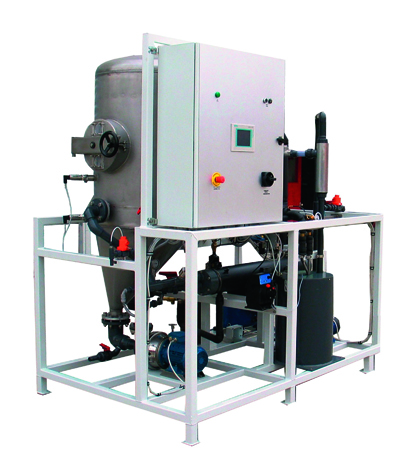
Solutex’s water vacuum evaporator WT50 can process 50 litres of water per hour
Solvent recycling
Sustainability is one of the major drivers in today’s packaging print industry as end users more and more demand reassurance that their environmental footprint is not adversely affected by the products they supply to their customers.
Solutex has been supplying its solvent recycling systems to the flexographic industry for many years, but it is perhaps not so well known that it also has a range of water vacuum evaporators for the printing industry.
Water vacuum evaporators can be used to treat the waste water from water-based printing systems, allowing the water to be recycled or discharged to drain. Solutex uses vacuum evaporation technology that effectively resolves the problem of the disposal of industrial polluted water, concentrating as much as possible the contaminating products, such as inks and reducing the amount of waste for off-site disposal.
The company’s systems exploit the technologies of heat pump and vacuum distillation that results in a high yield with low energy consumption. Under vacuum the boiling point of water is reduced to 35-40° C, using heat pump technology the same circuit is used for heating and cooling, and the amount of energy required is reduced considerably.
Solutex has a number of different systems that can be matched to customer requirements from low to high volume units. Most systems are supplied skid-mounted ready for easy installation. The company will carry out laboratory tests free of charge for any company considering a new installation.


